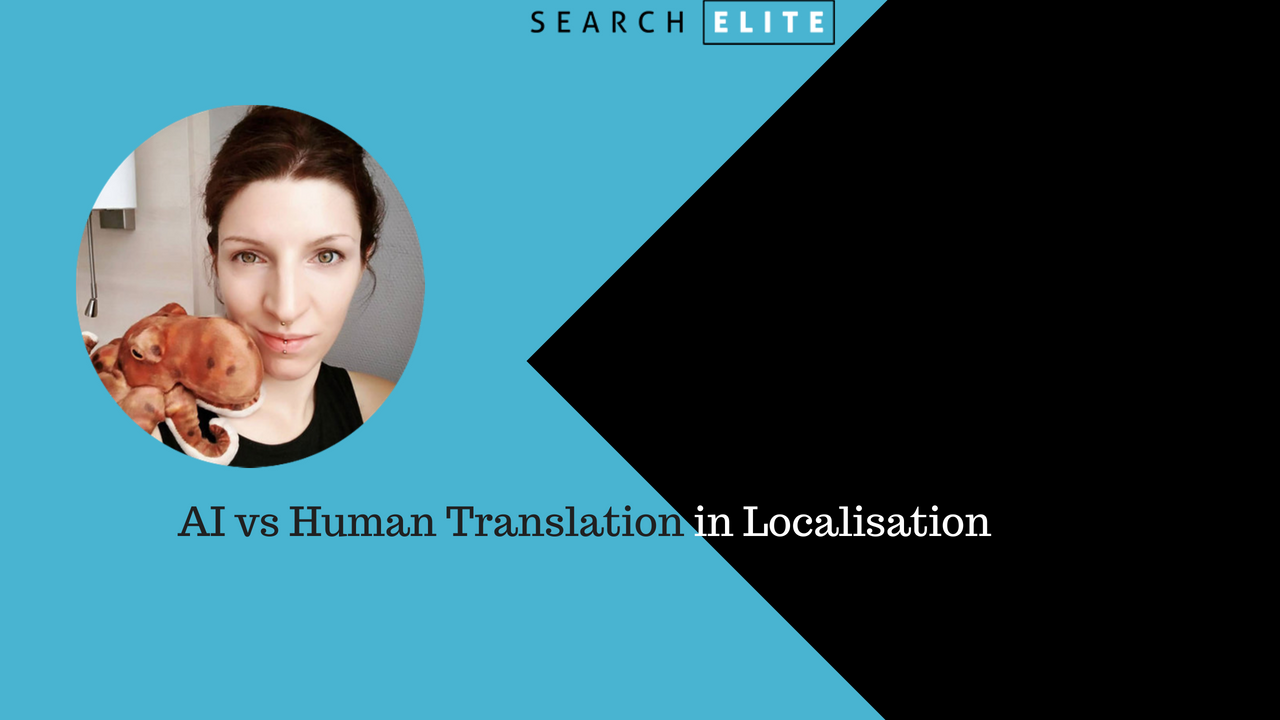Don’t get lost in translation
In today’s globalised world, businesses are looking to expand their reach and target customers from different countries. By far one of the most critical aspects of this expansion is localisation. Localisation involves adapting content to suit the language, cultural, and social norms of a particular country. It is an essential process for companies that want to establish their presence in different markets so they can reach a larger group of potential customers interested in their products or services.
Artificial Intelligence (AI) has played a significant role in the localisation process, particularly in the area of translation. Machine translation (also known as MT software) has come a long way, and many businesses are now relying on AI for their translation (transcreation) needs. However, the question remains, can Artificial Intelligence match human translation when it comes to localisation? With that in mind let’s explore the differences between AI and human translation in localisation.
AI Translation
Artificial Intelligence translation is the use of complex machine learning algorithms to translate text from one language to another. It involves the use of machine learning techniques that enable the algorithm to learn from large datasets of human translations and apply this knowledge to translate new text.
AI translation has come a long way in recent years, and the quality of translations has improved significantly. Amazon Translate is a good example of AI that delivers outstanding results in translation.
Naturally, AI translation has the advantage of being faster and more cost-effective than human translation. It is also suitable for handling large volumes of text, making it an ideal solution for international businesses that need to translate large amounts of content quickly.
The process of AI translation typically involves the following steps:
- Data collection: The first step is to collect a large dataset of human translations in the source and target languages. This dataset is used to train the machine learning algorithm.
- Preprocessing: The input data is preprocessed to remove any irrelevant or redundant information, such as punctuation and whitespace. This step is important to ensure that the algorithm is working with clean data.
- Training the algorithm: The machine learning algorithm is trained on the preprocessed dataset of human translations. During this process, the algorithm learns to identify patterns and relationships between words and phrases in the source and target languages.
- Testing and validation: Once the algorithm has been trained, it is tested and validated to ensure that it is producing accurate translations. This involves comparing the machine-generated translations to a set of reference translations.
- Fine-tuning: The algorithm may need to be fine-tuned to improve its accuracy. This may involve adjusting the parameters of the algorithm, such as the learning rate or the number of layers in the neural network (generally, a neural network can have as few as one layer, i.e., a single layer perceptron or as many as hundreds or even thousands of layers, i.e., deep neural networks).
- Deployment: Once the algorithm has been tested and validated, it can be deployed to translate text in real-world applications. The algorithm may be integrated into a translation platform or API, allowing users to translate text automatically.
Famous AI translation algorithms
There are several famous machine learning algorithms that are commonly used for translating text by various companies. Here are a few examples:
- Google Translate: Google Translate uses a machine learning algorithm called Google Neural Machine Translation (GNMT), which was introduced in 2016. GNMT uses deep learning techniques to translate text, allowing it to produce more accurate translations than previous versions of Google Translate. As far as I know, GNMT is trained on large datasets of parallel text, which are pairs of texts in different languages that have the same meaning. People say that in 2004 Sergey Brin, one of the co-founders of Google, had a bad experience with a licensed translation program that translated a Korean email into the nonsensical phrase, “The sliced raw fish shoes it wishes. Google green onion thing!”. This experience led Brin to conceive the idea of a more reliable and accurate machine translation service and Google Translate was born.
- Microsoft Translator: Microsoft Translator uses a machine learning algorithm called Neural Machine Translation (NMT), which was introduced in 2017 by Microsoft Research, the company’s research division. Neural Machine Translation is a machine translation approach utilising neural network techniques to predict the likelihood of words in sequence allowing it to produce more natural and fluent translations.
- Amazon Translate: Amazon Translate uses a machine learning algorithm called Neural Machine Translation (NMT), which was also introduced in 2017. Despite the same name Amazon and Microsoft have their own neural machine translation (NMT) systems, which are not the same thing. What I like about Amazon NMT is that it allows you to train and customize your own NMT model using your own data, whereas Microsoft Translator does not currently offer this option.
- OpenNMT: OpenNMT is an open-source machine learning toolkit for neural machine translation. It includes several machine learning algorithms, including convolutional neural networks (CNNs) and recurrent neural networks (RNNs), which can be used to translate text into multiple languages. OpenNMT is probably my favourite toolkit as its source code is available for anyone to access, modify, and distribute. This allows for greater flexibility and customization than a closed-source platform like Microsoft or Amazon NMT.
A suggestion I want to make here is to read this article Introducing the first AI model that translates 100 languages without relying on English.
Challenges of AI Translation in Localisation
While AI translation has come a long way, it still faces several challenges when it comes to localisation. One of the main challenges is the difficulty in understanding the nuances of language and culture. Languages are complex, and understanding the context and tone of a particular text can be difficult for a machine.
Another challenge is that the quality of the translation depends on the quality of the input data (‘good data in, good data out’ and unfortunately ‘bad data in, bad data out’). Machine learning algorithms rely on large datasets of human translations to learn and improve their translations. If the input data is of poor quality, then the machine-generated translations will also be of poor quality.
Finally, there is a risk of bias (lack of conceptual equivalence, misunderstanding of language and misinterpretation of meaning) in machine-generated translations. Machine learning algorithms are trained on large datasets of human translations, which may contain biases and inaccuracies. If these biases are not identified and corrected, then they can be perpetuated in machine-generated translations.
Note: Bias in machine learning is a big topic that I will explore in another future article.
Human Translation
Human translation involves the use of professional translators to translate text from one language to another. Professional translators are highly skilled and experienced individuals who understand the nuances of language and culture (one of the main challenges of machine translation is that language is highly contextual).
Professional translators are able to take into account the context of the text and the intended audience (and audiences can be totally different even within the same country), ensuring that the translation accurately reflects the meaning and tone of the original text.
Human translation is a time-consuming and costly process. It requires a high level of skill and expertise, and as such, it is often more expensive than AI translation. However, the advantage of human translation is that it produces high-quality translations that are accurate and culturally appropriate (important!).
Note: All professional translators should have a deep understanding of the culture and social norms of the target language, ensuring that the translation is suitable for the intended audience.
Last but not least, human translation provides a level of quality control that is not possible with AI translation. Professional translators are able to check and correct any errors or inaccuracies in the translation, ensuring that the final product is of the highest quality.
The process of human translation is fairly simple and involves 3 stages: analysis, translation, and revision.
- Analysis: The translator carefully analyses the source text, taking into account the context, tone, and intended audience.
- Translation: The second step is to translate the text, ensuring that the translation accurately reflects the meaning and tone of the original text.
- Revision: Finally, the translation is revised, with the translator checking and correcting any errors or inaccuracies.
AI vs Human Translation
When it comes to localisation, both AI and human translation have their advantages and disadvantages. AI translation is faster and more cost-effective than human translation, making it an ideal solution for businesses that need to translate large volumes of low priority content quickly. However as mentioned already AI translation can be less accurate than human translation, particularly when it comes to understanding the nuances of language and culture.
Human translation, on the other hand, produces high-quality translations that accurately reflect the meaning and tone of the original text. Professional translators understand the nuances of language and culture, ensuring that the translation is culturally appropriate and suitable for the intended audience. However, human translation is time-consuming and costly (simply put, machine translation costs less) making it less suitable for businesses that need to translate large volumes of content quickly.
The best approach to localisation depends on the specific needs of the business. For companies that need to translate large volumes of content quickly, AI translation may be the best solution. However, for businesses that require high-quality translations that accurately reflect the meaning and tone of the original text, human translation is the best option.
An example of companies that need to translate large volumes of content quickly would be media companies like publishers, broadcasters, and streaming services that may need to translate a high volume of content, such as articles, scripts, and subtitles, to cater to international audiences.
A good example of companies that require high-quality translations would be medical and pharmaceutical companies. Medical documents, such as clinical trial reports and regulatory submissions, require accurate translations to ensure that the information is communicated clearly and effectively. Inaccurate translations could lead to serious consequences for patients and regulatory issues.
It is also worth noting that the best approach to localisation may be a combination of AI and human translation. I actually strongly recommend this route. Artificial Intelligence translation can be used to translate large volumes of content quickly, while human translation can be used to refine and improve the translations, ensuring that they are accurate and culturally appropriate.
Conclusion
In conclusion, both AI and human translation have their advantages and disadvantages when it comes to localization. AI translation is faster and more cost-effective than human translation, making it an ideal solution for businesses that need to translate large volumes of content quickly. However, AI translation can be less accurate than human translation, particularly when it comes to understanding the nuances of language and culture.
Human translation, on the other hand, produces high-quality translations that accurately reflect the meaning and tone of the original text so probably the best way to go about translation is human supervised AI translation.
Who is Gianna Brachetti-Truskawa?
Gianna Brachetti-Truskawa is the Senior International SEO Manager at bold ventures GmbH. Her specialities are managing multilingual websites, hreflang implementation, schema.org, Rich Results and localisation (DE, EN, FR, IT).
Her insatiable curiosity covers more topics than there are hours in a week, but her special passion is language in all its different quirks and features – and food of course.

What is Search Elite?
Search marketing continues to be the biggest and most powerful form of digital marketing. Search Elite is a conference designed exclusively for experienced search marketers. All the sessions are fast-paced, Q&A-packed, always informative and delivering the most forward-thinking digital strategies and tactics.


Leave a Reply